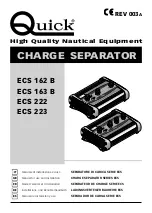
plate consists of a beryllium nickel disc spring that is
sealed on both its inside and outside edges with a Teflon
gasket. The compression screw, arms, and deflector are
bronze, and the mounting cup is steel. The cover plate
and enclosure are brass.
Patents
U.S.A. Patent Number 5,152,344 is applicable to the
Stealth Residential.
DESIGN CRITERIA
The Stealth S240 (SIN S2450) Residential Concealed
Pendent Sprinklers must only be installed and utilized in
accordance with the following described criteria which
are provided by the manufacturer.
NOTES
Residential Fire Sprinkler Systems should only be de-
signed and installed by those competent and com-
pletely familiar with automatic sprinkler system de-
sign, installation procedures, and techniques.
Several criteria may apply to the installation and us-
age of each sprinkler. Consequently, it is recom-
mended that the sprinkler system designer review
and develop a working understanding of the com-
plete list of criteria prior to initiating the design of the
sprinkler system.
Questions concerning sprinkler installation and usage
criteria which are not covered by the following instruc-
tions should be submitted to Technical Services. In-
clude sketches and technical details as appropriate.
In some instances, the requirements of this docu-
ment may concern specifications which are more
stringent and which take precedence over those
specified in NFPA 13, NFPA 13D, NFPA 13R, or by the
Authority Having Jurisdiction (AHJ).
The spray from the sprinkler is distributed radially
outward and downward from the sprinkler deflector.
Consequently, the sprinklers must be located such
that there will not be any blind spaces shielded from
spray by partitions, room dividers, overhangs or
other parts of the dwelling structure.
The number of sprinklers within each compartment
(as defined by NFPA 13, 13D, or 13R), must be kept
as few as possible. Do NOT use more sprinklers than
necessary to cover a particular space.
The sprinkler must be secured in position by firmly
fastening the sprinkler system piping to the struc-
ture. If the sprinkler is not properly secured in posi-
tion, reaction forces resulting from sprinkler opera-
tion could alter its orientation and its water
distribution pattern. The sprinkler escutcheon cannot
be used to hold the sprinkler in position.
General Service Conditions.
The Stealth Residential
must only be utilized in wet pipe sprinkler systems.
Hydraulic Design Criteria.
The minimum required flow
rates for residential applications are given in Table A as a
function of the maximum allowable coverage areas. The
NFPA 13D/13R single sprinkler flow rate is the minimum
required discharge from the most hydraulically demand-
ing single sprinkler and the NFPA 13D/13R multiple sprin-
kler flow rate is the minimum required discharge from
each of the total number of “design sprinklers” as speci-
fied in NFPA 13D or 13R.
TIA 99-1 (Tentative Interim Amendment) with an effective
date of May 22, 2000 states that the minimum required
discharge from each of the “design sprinklers” for sys-
tems designed to NFPA 13 must be calculated based on
delivering a minimum design density of 0.1 gpm/sq. ft. for
each of the listed coverage areas shown in Table A. Con-
sult with the Authority Having Jurisdiction regarding the
application of this TIA to the currently adopted NFPA 13.
For systems designed to NFPA 13, 13D, or 13R, consult
with the local authority having jurisdiction with regard to
the number of “design sprinklers” for sloped ceilings hav-
ing a slope greater than a 2 inch rise for a 12 inch run.
Spray Coverage Criteria.
Figures 3 and 4 provide spac-
ing rules that must be followed to assure that the Stealth
Residential will provide their design distribution of water
spray.
Operational Sensitivity Criteria.
For proper operational
sensitivity, the Stealth Residential must be installed be-
neath a solid ceiling having a smooth or textured surface
and in accordance with Figure 1.
The Stealth Residential must
NOT
be used above or be-
low open-gridded type suspended ceilings; beneath sof-
fits or beams resulting in a deflector-to-ceiling distance
(i.e., deflector-to-mounting surface plus depth of soffit or
beam) exceeding 4 inches; or, with beams, joists, or
ducts having a height of more than 3 inches located
within the sprinkler coverage areas. Beams having a
height of more than 3 inches may be located with their
centerlines along the boundaries separating adjacent
sprinkler coverage areas.
Cold Soldering Criteria.
Figures 3 and 4 provide the
minimum spacing requirements necessary for preventing
the wetting (i.e., cold soldering) of the heat responsive
STAR SPRINKLER
Page 2
1-3.1.11
DuPont Registered Trademark
(a) For coverage area dimensions less than or between those
indicated, it is necessary to use the minimum required flow for
the next highest coverage area for which hydraulic design
criteria are stated.
(b) Requirement is based on minimum flow in GPM from each
sprinkler. The associated residual pressures are calculated
using the nominal K-factor. Refer to Hydraulic Design Criteria
Section for details.
TABLE A
HYDRAULIC DESIGN CRITERIA
12 x 12
MAXIMUM
COVERAGE
AREA
(a)
FT. x FT.
NFPA
13D/13R
MINIMUM
SINGLE
SPRINKLER
FLOW
(b)
14 x 14
16 x 16
18 x 18
20 x 20
16 GPM
(14.5 PSI)
12 GPM
(8.2 PSI)
16 GPM
(14.5 PSI)
12 GPM
(8.2 PSI)
24 GPM
(32.7 PSI)
17 GPM
(16.4 PSI)
25 GPM
(35.4 PSI)
18 GPM
(18.4 PSI)
16 GPM
(14.5 PSI)
12 GPM
(8.2 PSI)
NFPA
13D/13R
MINIMUM
MULTIPLE
SPRINKLER
FLOW
(b)
OBSOLETE


























